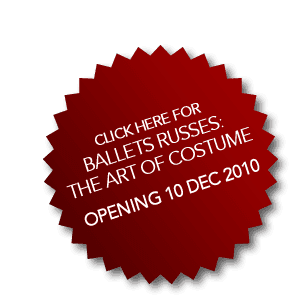|
The Russian Ballet,
also known as the Ballets Russes, was founded by Serge Diaghilev
(1872-1929). Diaghilev, the Russian Ballet's producer and creative director,
rejected conventional ideas of ballet. His great achievement was to integrate
design, music and dance. By encouraging the artistic collaboration of
painters, choreographers and composers, Diaghilev created a new art-modern
ballet. From 1909 until 1929 the company performed in Paris, throughout
Europe and in North and South America. Ironically, the Russian Ballet
company never appeared in Russia.
Designers
At first, the principal designers of the Russian Ballet's sets and costumes
were Léon Bakst
and Alexandre Benois.
Bakst caused a sensation with his brilliant visions of exotic cultures,
while Benois charmed the sophisticated Parisian audiences with his interpretations
of both Russian and French traditions. Artists of the avant-garde also
became associated with the Russian Ballet: Michel Larionov,
Natalia Goncharova
and Henri Matisse,
among others.
Music
Diaghilev chose music not normally associated with dance, and many of
the scores he commissioned have become twentieth-century classics. Igor
Stravinsky, a pioneer of modern music, launched his career with the company.
He was Diaghilev's closest musical collaborator and created the radical
work, The Rite of Spring 1913, for the Russian Ballet.
Dance
The company boasted five of this century's most innovative choreographers:
Michel Fokine, Vaslav Nijinsky, Léonide Massine, Bronislava Nijinska
and George Balanchine. They invented new ways of communicating ideas through
movement, as well as different steps and combinations. Nijinsky's performances
are legendary and the company's dancers, including Tamara Karsavina and
Adolph Bolm, became international stars.
The Russian Ballet
in Australia
After Diaghilev's death in 1929, several new companies, including Colonel
W. de
Basil's Russian Ballet, were formed. Using some original Diaghilev
sets and costumes, de Basil's company revived many of the productions.
De Basil also commissioned new productions. The company toured Australia
three times between 1936 and 1940. The tours had a tremendous impact and
helped to found modern ballet in this country.
The Exhibition
For years after the demise of de Basil's company in 1950, hundreds of
sets and costumes lay in storage in Paris. In 1973 the National Gallery
of Australia bought more than a hundred of these costumes at auction in
London. Works from Canberra's collection have been joined by splendid
designs and costumes from St Petersburg, London, Paris and Vienna.
The exhibition displays
the extraordinary designs made for the Russian Ballet from the Russian
season in Paris in 1909 to the avant-garde production of Destiny in 1933.
It includes costumes, drawings, photographs, theatre programs and even
a backdrop. There are four broad themes: Exoticism, Romance and Fairytales,
Russian Folklore and Modernism.
Education Kit
This education kit includes 11 images of costumes and designs from the exhibition From Russia with Love. Text on the reverse side of each image provides production information, some background about the designer and a description of the costumes. This is followed by quick comprehension questions, then suggestions for essays, activities and discussions, specific to each ballet.
The discussion topics and activities have been designed to address all the areas of the Arts curriculum: dance, drama, media studies, visual arts and music. The three strands of making, criticising and researching have also been covered.
Download Adobe Acrobat File (466KB)
Ballets
Russes Home
|
